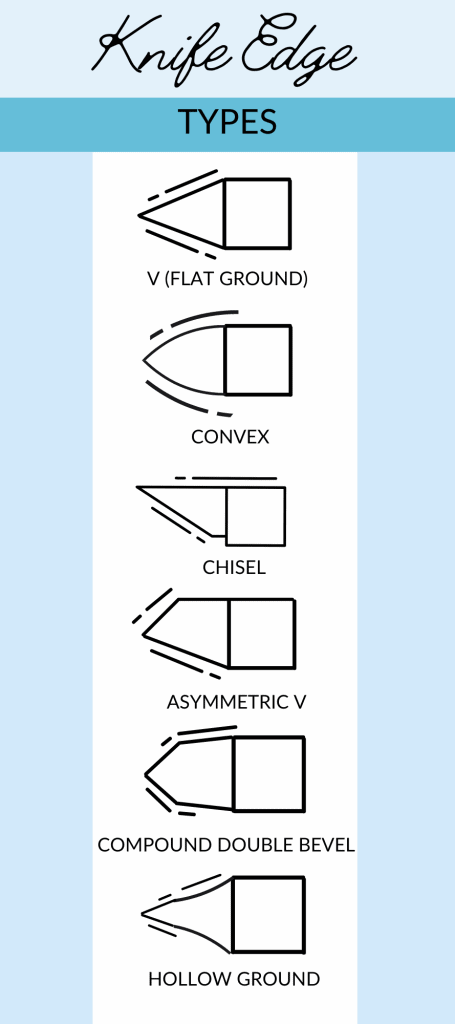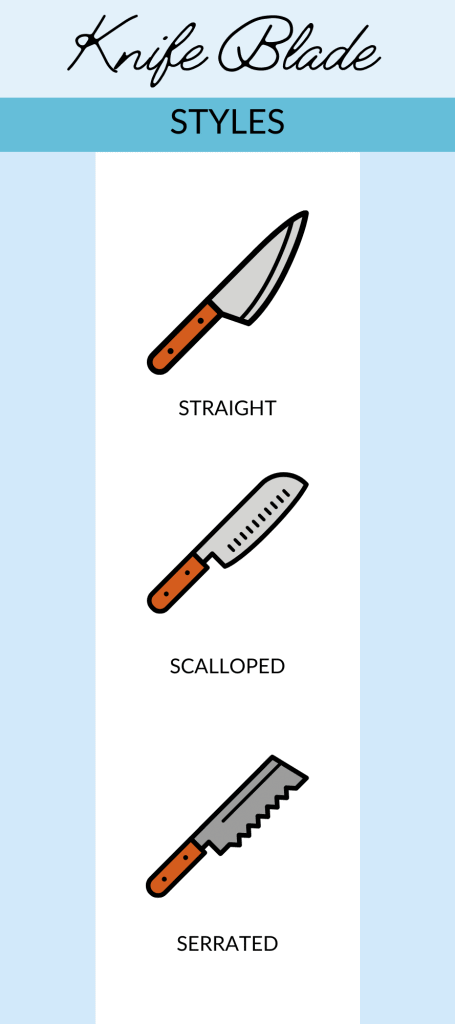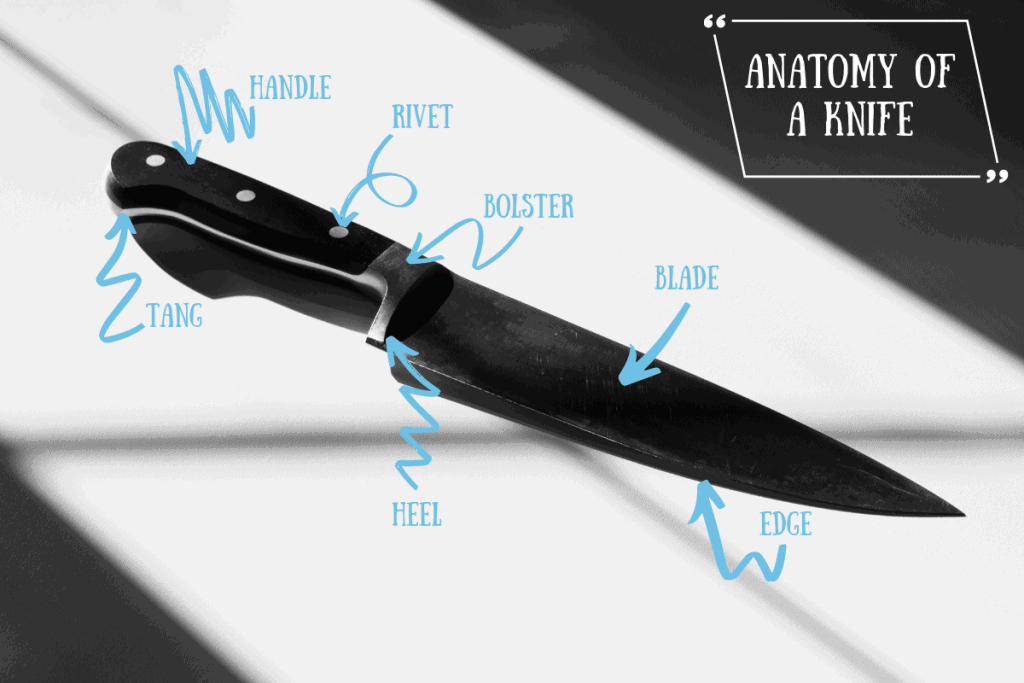Each part of a modern knife comes from a long tradition of bladesmithing, beginning with swords in the ancient era. Even today, the names and functions of the parts of a knife come from this lineage. And just as a samurai needed their sword, a chef needs their trusty kitchen knife!
I studied traditional blacksmithing and sword-making for years before I started working in kitchens. Now, after a decade of professional kitchen work, I’ve gained a unique perspective on the parts of a knife.
My goal in this article is to provide you with all the information you need to understand any knife you’re thinking about using in your kitchen. Use this study guide the next time you’re thinking of buying a knife, and you’ll be able to home in on the best choice for you.
In This Article
The Blade: Cutting Edge Technology
Knives are first and foremost judged by the quality of their blades. Once you know what to look for, you can decide whether any given knife is top quality or just another imitation.
There are five major parts that determine a blade’s style:
Edge
The edge is your knife’s reason for existing. Without it, you’d have a pretty piece of metal with no function at all!
Sharpness is the most important quality for a knife’s edge. In quest of razor-sharp edges, knife makers use top-quality steel, traditional forging methods, and are often aided by computerized sharpening tools.
Harder steel, like high carbon steel, can take a sharper edge than softer steel. Forged blades will always be able to take a sharper edge than stamped blades.
Additionally, there are seven ways to grind the blade. Each gives a different shape to the edge, making the knife better at certain sorts of cuts.

Spine
A knife’s spine is located on the opposite side as its cutting edge. Knife spines are thicker than their edges, giving the blade extra strength and durability. Chef’s knives and cleavers use a particularly thick spine to add weight and make large cuts easier.
Point
The point is the part of the blade where the spine and edge meet at the front of the knife. Simple as that! Paring knives are the only type of knife where you’ll regularly use the point to make cuts. Any large knife prioritizes using the length of the blade to make cuts.
Tip
Follow the edge back a few inches from the point, and you have the length of the tip of your knife. Use the tip of your knife for delicate cutting work, or to start longer cuts.
Heel
The heel is located on the opposite end of the edge from the tip. It’s situated directly next to a knife’s bolster. Use it to make quick, repetitive cuts, such as mincing garlic or onions.
Blade Styles
You’ll also find knives made with three distinct styles of blades:
- Straight blades are your stereotypical kitchen knife. And they’re, well, straight. 90% of kitchen knives use straight blades.
- Scalloped or Granton blades are scalloped along the sides of the blade, but still have a straight edge. This helps them cut through firm foods without sticking.
- Serrated blades strongly resemble a saw blade. They’re most commonly used for cutting bread.

The Bolster: Perfectly Balanced, As All Things Should Be
Placed smack in the center of a knife’s weight, the bolster is the pivot around which a knife is built. It’s the smallest part of the knife, and the most important for creating a balanced blade. Heavier bolsters let the knife do more of the cutting work for you, and increase the knife’s durability.
Let’s take a look at three distinct bolster styles:
Full Bolster
Full bolster designs extend from the junction of the handle and blade, all the way down the heel of the blade. They’re heavy and durable, providing a layer of protection between your forefinger and the cutting edge. Unfortunately, they also make it harder to use the whole length of a knife’s blade.
Half Bolster
Also known as semi or sloped bolsters, half bolsters blend smoothly into the heel of the knife. They provide excellent control over the knife and a comfortable weight. Best of all, they let you use the full length of the blade and keep the knife easy to sharpen.
No Bolster
The “no bolster” style is something of a misnomer, as there is obviously still a place where the blade meets the handle. It refers to a bolster that does not blend into the heel of the blade at all. Many older styles of Western and Japanese knives use this bolster style.
The Handle: Get A Grip
The blade may be the business end, but the handle is what keeps you cutting. A great handle will fit a wide variety of hands comfortably. And while the blade may be the main attraction, the handle will determine how aesthetically pleasing a knife is.
Scales
The material that a knife’s handle is made of is known as the scales. You’ll find handles made from either natural or synthetic materials. Wooden handles are the most traditional (and beautiful), but are not as antibacterial as plastic handles. Specialized polymer handles have a similar feel to wood, but are more durable and easier to maintain.
Tang
A knife’s tang is the part of the blade that leads into the handle. Full tang knives extend metal from the tip to the butt of the knife, and are especially durable. Semi-tang knives are less expensive, but more prone to damage from heavy use.
Rivets
Look at the handle of a knife. Do you see the two or three circular impressions? Those are the rivets, and their job is to keep your knife together. Rivets fasten the handle material to the tang of the knife, and can look quite nice too.
Butt
Also known as the pommel of the knife, the butt is farthest away from the point of the blade. Butts come in all shapes and sizes, from completely straight to noticeably curved.
Why Are There So Many Types of Knives?
When you’re first looking to buy knives for your kitchen, the prospects are daunting. Which types of knives do you need? Why are there so many shapes and sizes? Are German or Japanese knives better? Allow me to explain.
Each type of knife evolved from the needs of the cuisine and region it comes from. Japanese cuisine, for example, makes use of a lot of fish. Therefore, their chef’s knives are shaped in a way that makes them excellent for cutting fish. German knives, on the other hand, excel at cutting through the pork and beef more common to Continental cuisine. Even the materials used in knife blades are regionally specific. Japan prefers high carbon steel and Europe uses more flexible steel.
From there, more specialized knives developed to satisfy more specialized uses. Carving knives make quick work of whole roasts. Santoku knives can handle the fish, vegetables, and poultry used in Japanese home kitchens. Paring knives allow for precise and detailed peeling and pitting of fruits and vegetables, and so on. As long as there are new dishes being made, there will be improvements and innovations in knife designs!
Fixed Blade Vs. Folding Knives
You may have noticed that we haven’t discussed anything about folding knives in this article. What gives?
Well, to be frank, folding knives don’t have any place in a kitchen. Folding blade knives are wonderful for camping trips and survivalists, but they’re not the safest option for kitchen work. Fixed blade knives are larger, sturdier, and safer. In short, leave your folding knives with your camping gear (and out of the kitchen).
What Knife Features Do You Want In A Knife For Barbecue?
Big slabs of barbecued meat demand a lot from your kitchen knives. Unless your fixed blade knives are prepared to cut through thick roasts, you may struggle to make clean cuts. So what makes a blade best suited for barbecue?
First and foremost, you’ll need the right sizes of kitchen knives for your barbecued meats. Chef’s knives and cleavers are the best choices, as their thick spines and long blades make it easy to make large cuts. Then, look for full tang blades. They’re the strongest and most durable, easily able to stand up to the heavy work that barbecuing demands.
In Conclusion: Which Knives Make the Cut?
Now that you know the construction and design basics of kitchen knives, what sort of blade are you looking to add to your kitchen? If you’re looking for recommendations, I’d be flattered if you took a look at some of my other guides:
- This essential kitchen knives guide will walk you through choosing the best selection of knives on any budget.
- The best German knives guide goes deep into what makes Western-style blades great for home kitchens.
- The best Japanese knives guide puts a spotlight on traditional Japanese blade styles.







